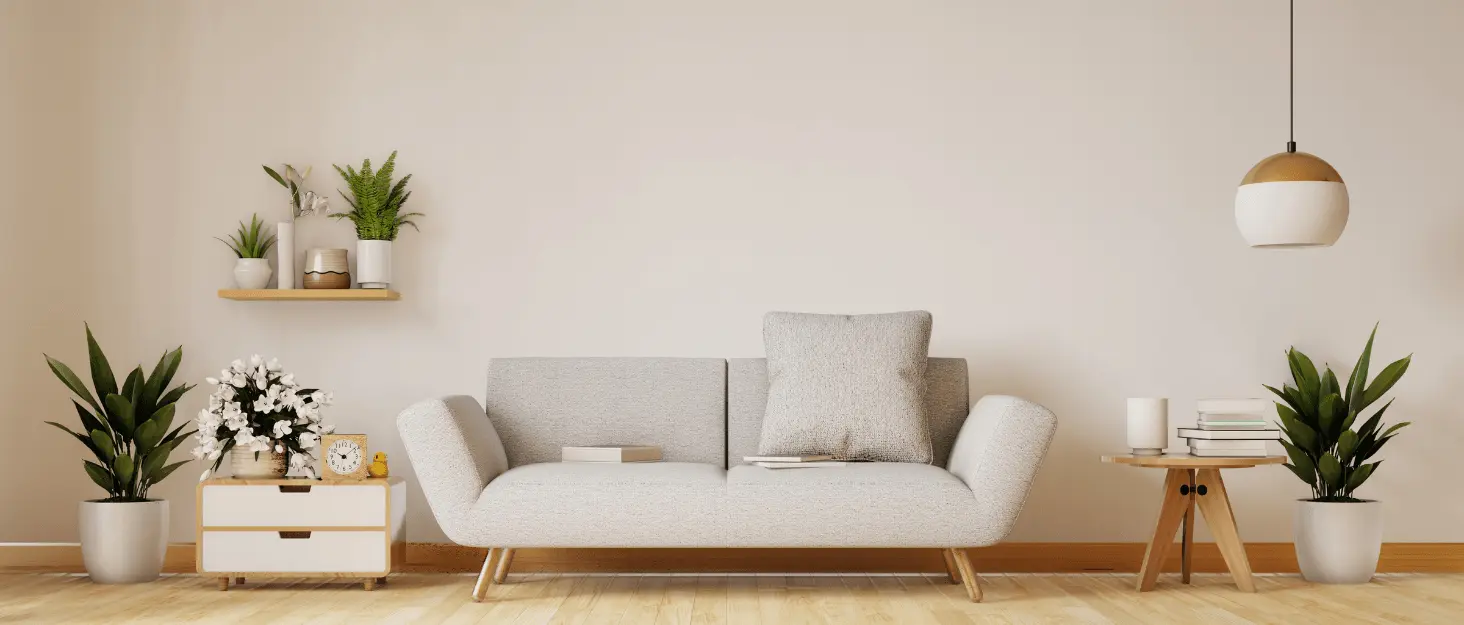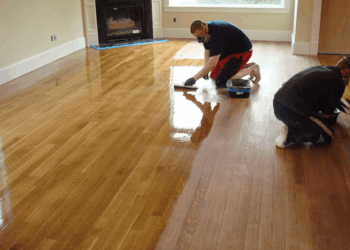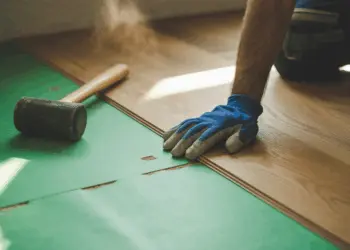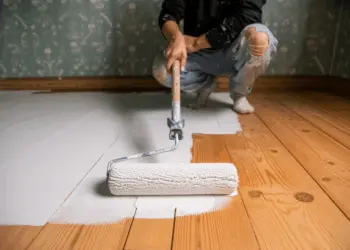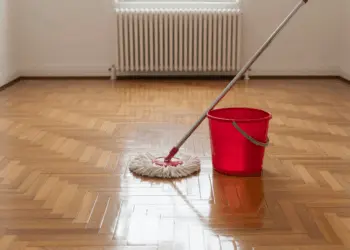When it comes to crafting beautiful living spaces, the floor often takes center stage. The interplay of colors, textures, and materials on the floor sets the tone for the entire room. Whether you’re a homeowner with a passion for interior design or someone looking to refresh their space, this exploration of floor and decor ideas will inspire you to transform your surroundings into a work of art.
Table of Contents
The Foundation: Flooring Selection
Types of Flooring Materials
Your choice of flooring material is the foundation of your design. From hardwood and laminate to tile and carpet, each material brings its unique character to a room. We’ll explore these options in-depth:
- Hardwood Flooring: Known for its timeless elegance, hardwood adds warmth and charm to any space. It comes in various wood species like oak, maple, and cherry, each with its own unique grain patterns.
- Laminate Flooring: An affordable alternative to hardwood, laminate flooring mimics the look of wood and is highly durable. It’s easy to install and maintain.
- Tile Flooring: Tiles, often made of ceramic or porcelain, are versatile and come in an array of styles and colors. They are ideal for high-traffic areas and moisture-prone spaces like bathrooms and kitchens.
- Carpet Flooring: Soft and comfortable, carpets offer a cozy atmosphere. They come in a wide range of colors and textures, making them perfect for bedrooms and living rooms.
- Vinyl Flooring: Vinyl is a resilient and cost-effective option. It can replicate the look of hardwood or tile and is highly resistant to moisture and stains.
- Bamboo Flooring: Bamboo is an eco-friendly choice, known for its sustainability. It has a unique appearance and is as durable as hardwood.
- Cork Flooring: Cork is another environmentally friendly option, offering a soft and cushioned surface. It’s resistant to mold and mildew, making it suitable for damp areas.
- Concrete Flooring: Polished concrete is a modern choice, offering an industrial and minimalistic look. It’s durable and easy to clean.
- Stone Flooring: Natural stone, such as marble, granite, and slate, provides a luxurious and elegant look. It’s often used in high-end homes and can last a lifetime with proper care.
- Linoleum Flooring: Linoleum is made from natural materials like linseed oil, making it an eco-friendly choice. It comes in various colors and patterns.
Matching Flooring to Room Functionality
Different rooms serve different purposes, and your choice of flooring should align with the functionality of the space. Let’s dive into how to match flooring to each room’s needs.
Living Room: Floor and Decor
- Needs: Comfort, durability, and style are essential. The living room is a high-traffic area, so you’ll want a durable and comfortable flooring material.
- Recommended Flooring: Hardwood, laminate, or carpet. These materials provide both comfort and durability while offering a range of style options.
Kitchen: Floor and Decor
- Needs: Kitchen floors should be easy to clean, moisture-resistant, and durable as they endure spills and heavy foot traffic.
- Recommended Flooring: Tile or vinyl. Both are easy to clean, resistant to moisture, and can withstand the demands of a busy kitchen.
Bathroom: Floor and Decor
- Needs: Bathrooms require flooring that can handle moisture without becoming slippery. Hygiene and easy cleaning are also crucial.
- Recommended Flooring: Ceramic or porcelain tile, as they are waterproof and easy to maintain. For added warmth, consider heated flooring options.
Bedroom: Floor and Decor
- Needs: Bedrooms should provide comfort and warmth. Noise insulation can also be important, especially in multi-story homes.
- Recommended Flooring: Carpet, hardwood, or laminate. These materials offer comfort, and you can add area rugs for extra warmth.
Dining Room: Floor and Decor
- Needs: The dining room needs flooring that can handle spills and is easy to clean. Style is also important for this space.
- Recommended Flooring: Hardwood, laminate, or tile. These materials are easy to clean and offer a range of design options.
Home Office: Floor and Decor
- Needs: A home office requires a comfortable and sound-absorbing floor for long hours of work.
- Recommended Flooring: Carpet or cork. They provide comfort and help reduce noise, creating a productive work environment.
Basement: Floor and Decor
- Needs: Basements are often prone to moisture, so the flooring must be moisture-resistant and durable.
- Recommended Flooring: Vinyl, tile, or engineered wood. These materials can withstand moisture and are easy to maintain.
Entryway/Hallway: Floor and Decor
- Needs: Entryways and hallways endure heavy traffic and exposure to the elements, so durability is key.
- Recommended Flooring: Tile or hardwood. They can withstand wear and tear and make a great first impression.
Children’s Playroom: Floor and Decor
- Needs: Safety, durability, and easy maintenance are paramount for playrooms.
- Recommended Flooring: Carpet or rubber flooring. These materials provide a soft surface for play and are easy to clean.
Colors and Textures: The Palette of Possibilities
The Impact of Color on Mood
Color is a powerful tool in interior design. We’ll look at how different colors can create various moods in your living spaces and guide you in choosing the right palette.
Red: Floor and Decor
- Mood: Red is a powerful and energetic color. It can evoke feelings of passion, warmth, and excitement.
- Use: Use red as an accent color to create a focal point in a room. It works well in dining areas, but excessive use can be overwhelming.
Blue: Floor and Decor
- Mood: Blue is calming and serene. It can create a sense of relaxation and tranquility.
- Use: Blue is ideal for bedrooms and bathrooms, where a peaceful atmosphere is desired. Lighter blues can make small rooms feel more spacious.
Green: Floor and Decor
- Mood: Green symbolizes nature and growth, imparting a sense of freshness and balance.
- Use: Green is versatile and suits various rooms. It’s perfect for living areas and kitchens, promoting harmony and a connection to the outdoors.
Yellow: Floor and Decor
- Mood: Yellow is cheerful and optimistic, instantly brightening a space.
- Use: Incorporate yellow in kitchens, dining rooms, and sunrooms to create an inviting and joyful atmosphere.
Purple: Floor and Decor
- Mood: Purple exudes luxury, creativity, and mystery. It can add a touch of sophistication to a room.
- Use: Consider purple for bedrooms, libraries, or areas where you want to stimulate imagination and contemplation.
Gray: Floor and Decor
- Mood: Gray is neutral and versatile, providing a sense of calm and balance.
- Use: Gray is perfect for creating a backdrop in any room. It complements other colors beautifully and allows them to shine.
Orange: Floor and Decor
- Mood: Orange is energetic and vibrant. It radiates enthusiasm and warmth.
- Use: Use orange sparingly in areas where you want to add vitality, like a home gym or a study space.
Pink: Floor and Decor
- Mood: Pink represents love, nurturing, and compassion. It’s a gentle and soothing color.
- Use: Pink works well in bedrooms, nurseries, and areas where a soft and nurturing ambiance is desired.
Brown: Floor and Decor
- Mood: Brown is earthy and stable, creating a sense of security and comfort.
- Use: Brown is a great choice for living rooms and home offices, where you want to foster a sense of coziness and stability.
White: Floor and Decor
- Mood: White signifies purity, cleanliness, and simplicity. It creates an open and airy feeling.
- Use: White is a classic choice for kitchens and bathrooms, making them feel fresh and inviting. It’s also ideal for small spaces.
Black: Floor and Decor
- Mood: Black is dramatic and sophisticated, often associated with luxury and elegance.
- Use: Use black sparingly in accessories, furniture, or accent walls to add depth and drama to a room.
Beige: Floor and Decor
- Mood: Beige is warm and versatile, offering a neutral and comfortable backdrop.
- Use: Beige is a great choice for creating a timeless and calming atmosphere in living rooms and bedrooms.
Balancing Textures for Visual Interest
Textures add depth and intrigue to your decor. We’ll discuss how to balance textures for a visually stimulating environment.
Mix Rough and Smooth Textures
- Combining rough textures like a shaggy rug with smooth surfaces like glass or polished wood creates contrast and visual interest.
Layer Textures
- Layering textures by adding elements like throws, pillows, and curtains can add depth and dimension to a space. Use varying textures within the same color scheme for a cohesive look.
Incorporate Natural Elements
- Natural textures like wood, stone, and plants introduce an organic feel to your space. They can balance the coldness of man-made materials and create a more inviting atmosphere.
Play with Patterns
- Patterns introduce a textural element. Combine patterns like stripes, florals, and geometric shapes in your decor to add visual complexity.
Contrast Light and Dark
- Balancing light and dark textures can create a visually striking effect. For example, pair a dark leather sofa with light, textured curtains.
Consider Scale
- Vary the scale of textures. Large-scale textures, like a chunky knit blanket, can be balanced with smaller-scale textures, like a fine-grained wooden table.
Mix Matte and Shiny
- Combining matte textures with shiny surfaces can create a beautiful interplay. Consider a matte-finish wall with glossy, reflective decor.
Texture on the Ceiling
- Don’t forget the ceiling. Incorporating textures like exposed beams or a textured ceiling paint can draw the eye upward and add a unique touch.
Artwork and Wall Decor
- Textured artwork, wall hangings, or wallpaper can introduce texture to your walls, contributing to the overall balance.
Use Natural Lighting
- Allow natural light to interact with various textures. It can emphasize the textures in a room and create an ever-changing visual experience throughout the day.
Avoid Overcrowding
- While mixing textures is essential, overdoing it can create visual chaos. Ensure there’s a sense of balance and cohesion in your design.
Test and Adjust
- Don’t be afraid to experiment and adjust. Try different textures and arrangements until you achieve the visual balance you desire.
Statement Pieces: Rugs and Carpets
Rugs as Art for the Floor
Rugs and carpets are more than functional; they’re artistic statements. Discover how to use these pieces to elevate your decor.
Define Zones
- Rugs can help delineate different functional areas within a room. For instance, place a rug under the dining table to define the dining area or under the coffee table to anchor the seating space in the living room.
Size Matters
- The size of the rug is crucial. In the dining room, ensure the rug accommodates both the table and chairs, allowing enough space for chairs to slide in and out comfortably. In the living room, the rug should be large enough to encompass the seating area, with a few inches of space between the rug and the walls.
Layering
- Layering rugs can add depth and interest. Place a smaller rug on top of a larger one to create a compelling focal point or to define a cozy reading nook within a larger room.
Color and Pattern
- Rugs can introduce color and pattern into a room. Choose a rug that complements your existing decor or use it as a starting point for your design scheme. If the room has neutral colors, a bold, patterned rug can become the centerpiece.
Texture and Comfort
- Opt for rugs with varying textures. In the bedroom, a plush, soft rug can be a treat for your feet in the morning. In high-traffic areas, consider low-pile or flat-weave rugs for durability.
Runners
- Hallways and entryways benefit from runner rugs. They add style, protect the floor, and guide the flow of traffic.
Material Matters
- Consider the material of the rug. Natural materials like wool and jute are durable and add a touch of eco-friendliness. Synthetic materials are often more budget-friendly and stain-resistant.
Maintenance
- Regularly clean and maintain your rugs to keep them looking their best. Vacuum regularly, and consider professional cleaning for deep stains or odors.
Seasonal Changes
- You can switch rugs with the seasons to refresh the look of a room. Lighter, airy rugs work well in spring and summer, while warmer, cozy rugs suit fall and winter.
Outdoor Rugs
- Don’t forget about outdoor spaces. Outdoor rugs can add style and comfort to your patio, deck, or balcony.
Personal Touch
- Select rugs that resonate with your personal style. Your rugs should reflect your taste and make your home feel like yours.
Safety First
- Ensure rugs have anti-slip pads, especially if they are placed on hard surfaces. This prevents accidents and keeps the rugs in place.
Experiment
- Feel free to experiment with unconventional placements or shapes. A round rug under a circular dining table or a sheepskin rug draped over a chair can bring a touch of whimsy to your decor.
Hardwood Elegance: A Timeless Classic
The Warmth of Hardwood
Hardwood flooring is a classic option, adding warmth and sophistication to any room. It comes in a wide range of wood species, finishes, and plank sizes, allowing you to create a unique look tailored to your style. and it is benefits to environmental, Many hardwoods are sustainably sourced, making them an eco-friendly choice for environmentally conscious homeowners.
Hardwood in Different Home Styles
From traditional to modern, hardwood can adapt to various home styles. Learn how to incorporate hardwood into your decor.
- Traditional Home:
- In a traditional home, rich and warm hardwood floors, such as oak or cherry, are a perfect match. The classic, timeless look of hardwood complements the traditional architecture, crown molding, and ornate furnishings. Opt for darker stains and wide plank flooring for an elegant and inviting atmosphere.
- Modern Minimalist:
- Hardwood floors can anchor a minimalist home with their clean lines and simplicity. Lighter wood species like maple or birch can create a sleek, airy feel. Opt for narrow plank widths and matte finishes to maintain the minimalist aesthetic, allowing the furniture and architectural elements to take center stage.
- Coastal and Nautical:
- In coastal-inspired homes, lighter hardwoods like white oak or hickory are ideal. The natural tones of these woods evoke a beachy, relaxed atmosphere. Add a distressed finish for a weathered look, or choose a white-washed hardwood to capture the essence of a seaside retreat.
- Rustic Farmhouse:
- Hardwood flooring is a staple in rustic farmhouse design. Reclaimed wood or distressed hardwoods like pine or walnut can create the perfect rustic ambiance. The imperfections and character of these floors add to the charm, making them an excellent choice for a cozy, country-style home.
- Contemporary Urban:
- In contemporary urban spaces, dark hardwoods like mahogany or Brazilian cherry can lend a sense of sophistication and contrast. Sleek and polished finishes work well in these settings, creating a refined and elegant atmosphere that complements modern furnishings and urban deco
Tiled Brilliance: Creative Tile Options
Versatility of Tile
Tiles offer limitless design possibilities. We’ll delve into the versatility of tile materials and designs.
- Flooring:
- Tiles are a popular choice for flooring due to their durability and wide variety of styles. From classic ceramic to modern porcelain and natural stone, they can fit into any design scheme. Whether you prefer a sleek and polished look or a rustic, textured finish, tiles have you covered.
- Backsplashes:
- Kitchen and bathroom backsplashes benefit from the practicality and style of tiles. They protect your walls from moisture and splatters while adding a visually appealing element. Mosaic, subway, and decorative tiles can transform these spaces into focal points.
- Bathrooms:
- Tiles are a natural fit for bathrooms. They are water-resistant and come in various sizes and shapes, allowing you to create intricate patterns or minimalist designs. From floor to shower walls and even the ceiling, tiles can unify the look of your bathroom.
- Fireplaces:
- Tiling your fireplace can make it a stunning focal point. You can choose from natural stone for a rustic appearance or sleek glass tiles for a modern touch. Tiled fireplaces add texture and character to your living room or bedroom.
- Outdoor Spaces:
- Tiles aren’t confined to the indoors. Outdoor tiles, like porcelain pavers or natural stone, are ideal for patios, pool areas, and walkways. They are slip-resistant and can withstand the elements, adding style and functionality to your outdoor spaces.
Underfoot Comfort: Flooring Accessories
Enhancing Comfort and Style
Flooring accessories like underlays and cushions enhance comfort and style.
The Versatility of Floor Accessories
From baseboards to transitions, floor accessories provide the finishing touches.
Vertical Innovations: Wall and Floor Combos
Taking Decor Beyond Floors
We’ll explore how wall and floor combinations can elevate your decor.
- Create Visual Harmony:
- Coordinating wall and floor materials in terms of color, texture, or pattern creates a sense of visual harmony.
- Define Spaces:
- Distinct wall and floor materials can help define different areas within an open-concept space. For example, a change in flooring from the living room to the dining area can delineate these spaces effectively.
- Add Depth and Dimension:
- Contrasting materials can add depth and dimension to a room. A feature wall with a different texture or color from the floor can create a captivating focal point.
- Balance Natural Light:
- The combination of wall and floor materials can impact how natural light is reflected in a room. Light-colored walls and floors can make a space feel brighter, while darker materials can create a cozy atmosphere.
- Enhance a Theme:
- Matching wall and floor materials to a specific theme, such as a coastal or rustic style, can amplify the theme’s impact. For instance, a room with wood-paneled walls and hardwood floors can exude a warm, cabin-like feel.
- Amp Up Texture:
- Mixing textures on walls and floors can make a room more interesting. Combining sleek, shiny floors with textured or patterned walls can add tactile appeal.
- Highlight Architectural Details:
- The right combination can accentuate architectural features. For example, stone walls paired with limestone floors can emphasize a room’s grandeur.
- Enhance Color Schemes:
- Coordinating wall and floor colors can tie your entire color scheme together. For example, matching gray walls with gray floors can create a contemporary, monochromatic look.
- Transform Small Spaces:
- In smaller rooms, light-colored walls and floors can create an illusion of more space. Additionally, using the same material on both surfaces can make a space appear larger and airier.
FAQs
How do I choose the right flooring material for each room?
Selecting the right flooring material involves considering the room’s functionality, your preferences, and the material’s durability. We’ll guide you through the decision-making process.
What color scheme works best with different types of flooring?
The choice of colors depends on the mood and style you want to create. We’ll offer insights into selecting the perfect color scheme for various flooring types.
Can I use area rugs on top of wall-to-wall carpeting?
Absolutely! Area rugs can add depth and style even on wall-to-wall carpeting. We’ll show you how to make this combination work seamlessly.
Are there eco-friendly flooring options available?
Yes, there are many eco-friendly flooring options, from bamboo and cork to recycled materials. We’ll introduce you to sustainable choices.
How can I make my floors stand out without a major renovation?
There are several ways to make your floors stand out without a full renovation.
Why is floor and decor so cheap?
Floor and Decor can offer lower prices due to their business model, which focuses on large selections and direct sourcing from manufacturers.
What does floor and decor mean?
“Floor and Decor” typically refers to a retail store specializing in flooring and home decor products.
Who is the CEO of Floor and Decor?
the CEO of Floor and Decor Holdings, Inc. was Tom Taylor
Is floor and decor a home depot
Floor and Decor is a separate company from The Home Depot; they are not the same company.
